|
The Mosque:
Although its spreading
goes back to the 11th century, Islam was more or less limited to urban
centers such as Djenne, Dia, Timbuktu and Gao. It was the faith of the
elite in power and of the trading community. It is only after a series
of holy wars in the 19th century that Islam definitely took root in
rural zones and in Dogon country.
Most villages have
a mosque. Today's dynamism of traditional mud constructions manifests
itself, among others, in a variety of mosques that show stylistic features
that are characteristic of Dogon architecture. Mosques with façades
composed of niches with checkerboard and triangular patterns became
a familiar sight.
The mosque of Kani
Kombole is a good example. It is situated at the foot of the escarpment.
There is ample space for building. The mosque is wide and its four sides
are decorated with colonnades and niches. This is a clear reference
to the façade of the Ginna namely, the traditional house of the extended
family.
|
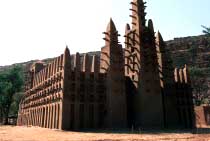 |
|
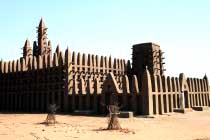 |
|
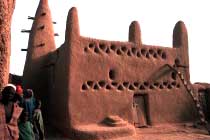 |
|
kani
kombole
|
|
kani
kombole
|
|
temba
|
| |
|
|
|
|
|
The mosque of Nando
is a case apart. Its foundation seems to go back to the 12th century.
It is older than the wellknown mosques of Djenne and Timbuktu. In those
days the Tellem were still the masters of the Bandiagara escarpment.
Today many questions remain unanswered as to the circumstances of its
founding. A local legend says that a giant built the mosque within a
few days. Not far from Nando he left a footprint in the rocks (see photo
hereunder). In those ancient times the only town close by and already
converted to Islam was Dia (on the Diaka, arm of the Niger). Was the
Nando region already a transit passage for early trans-Saharan trade
routes linking West to Northern Africa ?
Through the centuries,
the regular plastering with mud explains why the mosque on the outside
has a great resemblance with Dogon architecture. Inside the mosque,
however, the walls are Islamic in design and are decorated with themes
from the Koran : A pair of scales is weighing the souls of the deceased
so as to determine who will go to heaven or hell.
|
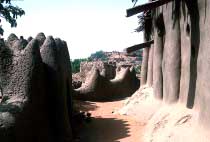 |
|
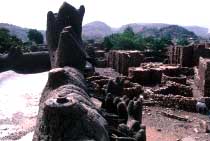 |
|
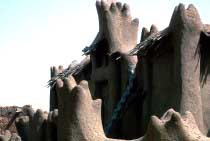 |
|
nando
(pignari)
|
|
nando
(pignari)
|
|
nando
(pignari)
|
| |
|
|
|
|
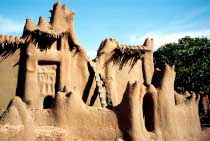 |
|
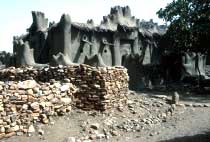 |
|
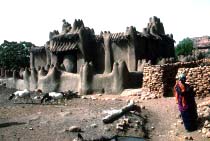 |
|
nando
(pignari)
|
|
nando
(pignari)
|
|
nando
(pignari)
|
| |
|
|
|
|
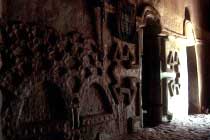 |
|
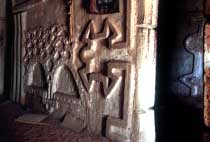 |
|
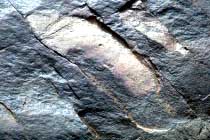 |
|
nando
(pignari)
|
|
nando
(pignari)
|
|
nando
(pignari)
|
|
On the plateau,
land suitable for cultivation will never be used for any other purpose.
Villages are built on hills that dominate the area. Kargue and
Danisare are no exceptions to the rule. Space available for construction
is limited. Both mosques stand high and their contours are adjusted
to the uneven topography of the site.
|
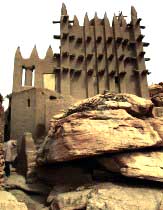 |
|
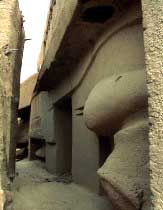 |
|
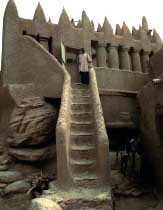 |
|
kargue
(lowel geou)
|
|
kargue
(lowel geou)
|
|
kargue
(lowel geou)
|
| |
|
|
|
|
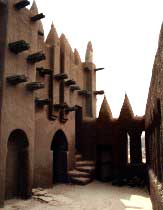 |
|
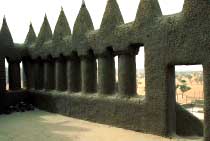 |
|
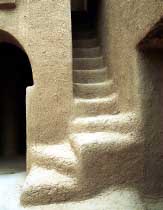 |
|
kargue
(lowel geou)
|
|
kargue
(lowel geou)
|
|
kargue
(lowel geou)
|
| |
|
|
|
|
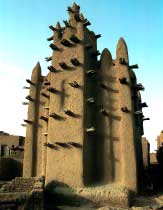 |
|
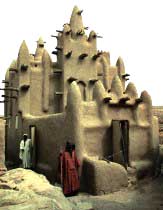 |
|
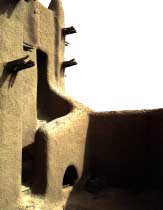 |
|
danisare
(lowel geou)
|
|
danisare
(lowel geou)
|
|
danisare
(lowel geou)
|
|
Ningari
is situated in the center of the plateau (Waduba) not far from Kani
Gogouna, capital of the Saman. This
group is ethnically related to the Djennenke of the Lowel-Gueou (see
page 06). But unlike them, they adopted
the local language and culture of their Dogon hosts. The
arrival of the Saman in Dogon country dates back to the 15th century.
Just like the Dogon, the first migrants reached the south of the Bandiagara
escarpment near the village of Kani Bonzon, and from there on, moved
towards the center of the plateau. Their settlement in the Waduba is
the result of many migrations that span some 300 years and that were
caused by incessant conflicts along the shores of the Niger river. Dogon
and Saman concluded alliances and shared a same territory in a relative
peace. Originally the Saman were no agriculturists like the Dogon. They
were a warlike people making a living from plundering. This attitude
served the Dogon to a certain extent as a rampart against the Fulani
enemy located at Dè on the plateau to the east. In the 19th century,
however, to extend their domination on the plateau, the Saman sided
at first with the theocratic state of Sekou Amadou, and thereafter with
El Haj Omar, the Futankobe conqueror. Both these states were leading
a holy war in the region. The Dogon never forgave their Saman allies
of their treachery. Among Dogon masks, one mask represents the "Samana".
When this mask dances, it will make all kinds of funny gesticulations
and the spectators will laugh at it. Conflicts
still arise on occasion. In the nineties the Saman in Kani Gogouna intended
to build a new mosque at the site of an old Ginna (traditional house
of the extended family). As the Saman have no rights on land ownership,
the Dogon opposed the project and got their way after a tense spell
of time that could have deteriorated into violence. The mosque of Ningari
is stylistically close to the mosques of the Niger river bank. Today,
after living for so many centuries on the plateau, the Saman say they
are Dogon but they will not forgo their Djennenke identity.
see :
- J.C.
Moine : "Gens de Djenné" en pays Dogon - les Dianangué (Djennenké)
des vallées du Diéou
- o
G.Holder " Poussière Ò Poussière "
|
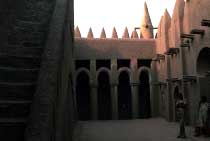 |
|
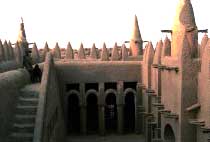 |
|
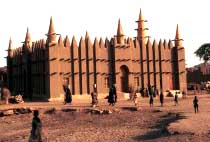 |
|
ningari
(waduba)
|
|
ningari
(waduba)
|
|
ningari
(waduba)
|
|
The pinnacles of
mosques are always exposed to rain. To limit water infiltration, they
are topped by specially made earthenware.
In Tanga,
however, the mosque's pinnacles are surmounted with overturned three-legged
bowls. Archaeologists do know well this type of ancient earthenware
that is commonly found in excavations in the cliff area (Tellem caves)
and along the shores of the Niger. It looks as if the inhabitants of
Tanga, having at their disposal a number of ancient pots, used these
instead of the usual earthenware specifically made for protecting pinnacles.
Next to the mosque's entrance there are still more pinnacles with pots.
Do they serve any religious purpose or is it just a matter of using
up the remaining pots ?
|
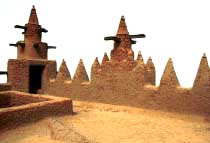 |
|
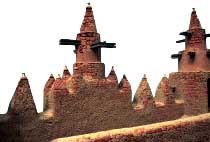 |
|
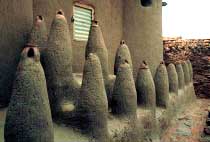 |
|
tanga
(n'duleri)
|
|
tanga
(n'duleri)
|
|
tanga
(n'duleri)
|
|
Hereunder still
some other mosques showing a variety of
stylistic features:
|
 |
|
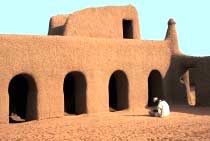 |
|
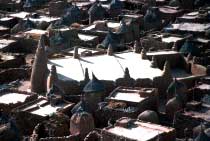 |
|
dourou
|
|
bandiagara
|
|
songo
|
| |
|
|
|
|
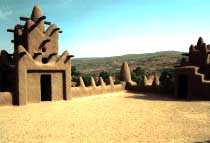 |
|
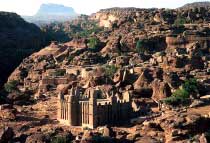 |
|
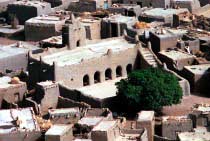 |
|
boui
(lowel gueou)
|
|
bargue
|
|
borko
(bondoum)
|
|
|
|
|
|
|
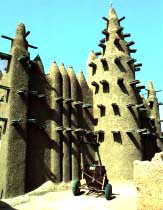 |
|
 |
|
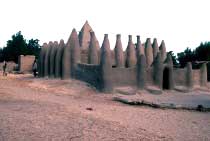 |
|
koko
(lowel gueou)
|
|
oropa
(plaine of seno-gondo)
|
|
plain
of seno-gondo
|
| |
|
|
|
|
|
|